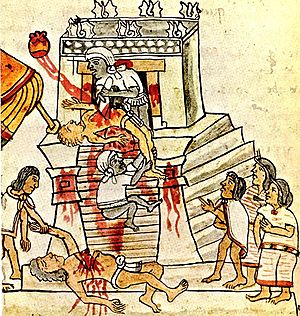
Turok himself is a generic Indian. His appearance, almost identical to his look in his 1954 debut, is fine. As Shooter said, he's a "warrior wise and strong. He's not particularly interesting.
His background, such as it is, is also generic. He's traveled across the American continent. He knows a few Indian words, including one in Ojibwe. He has a steel knife and axe he got from a Viking. He had no other tribal or cultural markers--nothing except generic talk of spirits and shamans.
His initial adventure is also generic. He saves the boy Andar from the evil Aztecs. Turok and Andar flee down a mystical tunnel to the Land of the Lost with the bad guys in hot pursuit. After a couple of attacks and escapes, Turok comes face to face with--wait, you've probably never heard this one before--a scantily-clad high priestess and her dark-skinned minions.
Those evil Aztecs
The big problem here isn't Turok, it's the evil Lord Maxtla and his men. They're portrayed as renegades, too cruel and barbaric even for the Aztecs. But since they're the only Aztecs I think we'll see, it's fair to treat them as representative.
Naturally, the comic portrays these Indians with the usual indicators of evil: bones, piercings, warpaint, earrings, necklaces, claws, plates, and the ever-popular shaved heads. No evil Indian ever goes unadorned. It's important to look like a scary demon or skeleton 24/7, even when no one else is around. Imagine going to the mess hall with your fellow evildoers and not looking like a vision from hell!
Maxtla is the evillest of the evil because he wears a dinosaur or crocodile skull over his head. Never mind that this headgear occurs only in bad comic books and jungle movies, or that it would interfere with his peripheral vision and hearing during combat. Scary people wear scary skulls...case closed!
There's plenty wrong with this portrayal of Aztecs, but most readers won't notice the flaws. Among them:
When they find themselves in dinosaur land, they decide they'll conquer that too. Right, because a few dozen Aztecs can do pretty much anything. They could conquer Europe if they happened to wind up there.
In reality, they might be able to conquer a small tribe or two, but any substantial civilization would quickly crush them. It's ridiculous to portray them as sticking to their psychotic goals no matter where they go or what they do. It means they're cardboard, cartoon villains, not worthy adversaries.
The sacrifice issue
Human sacrifice in Aztec culture
Human sacrifice was in this sense the highest level of an entire panoply of offerings through which the Aztecs sought to repay their debt to the gods. Both Sahagún and Toribio de Benavente (also called "Motolinía") observed that the Aztecs gladly parted with everything: burying, smashing, sinking, slaying vast quantities of quail, rabbits, dogs, feathers, flowers, insects, beans, grains, paper, rubber and treasures as sacrifices.
Before and during the killing, priests and audience (who gathered in the plaza below) stabbed, pierced and bled themselves as autosacrifice (Sahagun, Bk. 2: 3: 8, 20: 49, 21: 47). Hymns, whistles, spectacular costumed dances and percussive music marked different phases of the rite.

Exactly none of this appears in Shooter's TUROK. None of this complex cosmology is equivalent to: "Butcher the innocent victim because we're evil and our evil gods demand blood!" This is why people think Indians were uncivilized: because the media fails to show the civilization.
Conclusion
Alas, TUROK gives us little but stupid stereotyping. Turok the noble savage is the exception to the rule: that most Indians are savage beast-men with no goal except fighting and killing. Shooter and company have "successfully" reinforced a century-plus of Native stereotypes.
Ironically, the reprint of Turok's 1954 debut shows the original series was less stereotypical. Here Turok's and Andar's speech is somewhat stilted, and Andar sometimes grunts "ugh." But there are no huge swaths of savagery on display--just a man with good hunting and survival skills.
For more on human sacrifice, see Human Sacrifice in Aztec Pantheon and Human Sacrifice "Prevalent" Among Indians?

No comments:
Post a Comment